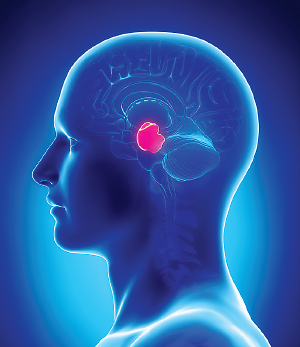Serotonin Transporter Binding Low in Suicide Attempters
Abstract
Brain imaging might eventually be used to predict suicide risk, following a finding that low serotonin transporter binding is associated with suicide attempts.
The brain biology of depressed individuals who have attempted suicide seems to differ from that of depressed individuals who have not attempted suicide.
So reported Jeffrey Miller, M.D., an assistant professor of clinical psychiatry at Columbia University, and colleagues March 4 in Biological Psychiatry.

Serotonin transporter binding in the midbrain, shown here, is linked with risk of suicide attempts.
Miller and his team conducted a PET brain imaging study of 51 subjects with major depressive disorder—15 of whom had also attempted suicide—as well as of 32 healthy control subjects. They found that the depressed suicide attempters had significantly lower binding of the serotonin transporter in the midbrain region than did depressed subjects who had not made a suicide attempt and than did healthy control subjects. Thus, “Low midbrain serotonin transporter binding appears to be related to the pathophysiology of suicidal behavior rather than of major depressive disorder,” Miller and his colleagues concluded.
This finding is “important,” Fabrice Jollant, M.D., Ph.D., an assistant professor of psychiatry at McGill University and an expert on suicide imaging, told Psychiatric News. “The finding is in line with numerous biological investigations conducted over the past 35 years using biochemical measures in the cerebrospinal fluid, cellular and molecular explorations in postmortem studies, neuropsychology, or structural and functional neuroimaging.” For instance, low serotonin levels in the cerebrospinal fluid have been linked with suicide behavior in prior research studies.
It would also be helpful if the finding could be used to identify individuals prone to suicide before they act on it, Jollant indicated, as “clinicians clearly need to improve their predictive ability.” The problem, however, is that while the differences in serotonin transporter binding between the suicide attempters and nonattempters or between the suicide attempters and controls “were statistically significant, there were large overlaps,” he said. “So I think that there are a lot of uncertainties regarding the use of [serotonin binding levels] in the near future to predict suicide risk.”
What is now needed, he pointed out, is a “longitudinal study with a sufficient number of participants and a sufficient duration of follow-up” to determine whether serotonin transporter binding levels can truly help predict who is going to attempt suicide.
And Miller said that he and his colleagues are already conducting such an investigation. “We will be following the subjects who are already enrolled in this study, conducting detailed psychological interviews three months, one year, and two years after PET scanning. At these time points, in addition to acquiring other clinical data, we will assess suicidal behavior and ideation in the intervening period since the last interview. These data will allow us to examine whether serotonin transporter levels as assessed by PET imaging play a role in predicting future suicide attempts over time.”
The study was funded by the National Institute of Mental Health. ■
An abstract of “Positive Emission Tomography Quantification of Serotonin Transporter in Suicide Attempters With Major Depressive Disorder” is posted at http://www.biologicalpsychiatryjournal.com/article/S0006-3223(13)00095-4/abstract.



